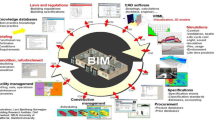Abstract
In this modern age of the construction industry, the building sector has consumed around 35–50% of energy. Sustainable development has therefore become an essential factor to reduce the impact on the environment. The traditional brick used as a walling material has been a major contributor to the environmental adversity so finding an alternative has become the need of the hour. In this paper, the comparative analysis of various walling materials is done to determine the most suitable and sustainable one. The analysis is done using Building information modelling (BIM). The comparison is carried out by creating a 3D building model in Revit 2019. The sun-path analysis, heating and cooling load analysis, Wind analysis and shading/lighting analysis are performed. Technical, social, environmental, and economic aspects are also considered for comparative analysis. Analytic hierarchy process (AHP) is used as the decision-making process to determine the best walling material. The comparative analysis concludes that walling materials using waste are useful for achieving the goal of sustainable solution.
Access this chapter
Tax calculation will be finalised at checkout
Purchases are for personal use only
Similar content being viewed by others
References
Abdelalim AM (2019) Integrating BIM-based simulation technique for sustainable building design. In: International congress and exhibition sustainable civil infrastructures: innovative infrastructure geotechnology. Springer, Cham
Adewale BA et al (2018) Dataset on cost comparative analysis of different walling materials in residential buildings in a developing economy. Data Brief 19:1918–1924
Ajayi SO et al (2015) Life cycle environmental performance of material specification: a BIM-enhanced comparative assessment. Int J Sustain Build Technol Urban Dev 6(1):14–24
Ashby MF et al (2004) Selection strategies for materials and processes. Mater Des 25(1):51–67
Azhar S, Brown J, Farooqui R (2009) BIM-based sustainability analysis: an evaluation of building performance analysis software. In: Proceedings of the 45th ASC annual conference, vol 1, No. 4
Ceranic B, Latham D, Dean A (2015) Sustainable design and building information modelling: case study of energy plus house, Hieron’s Wood, Derbyshire UK. Energy Procedia 83:434–443
Charef R, Alaka H, Emmitt S (2018) Beyond the third dimension of BIM: a systematic review of literature and assessment of professional views. J Build Eng 19:242–257
Chong HY (2016) Comparative analysis on the adoption and use of BIM in road infrastructure projects. J Manage Eng 32(6):05016021
Dissanayake DMKW, Jayasinghe C, Jayasinghe MTR (2017) A comparative embodied energy analysis of a house with recycled expanded polystyrene (EPS) based foam concrete wall panels. Energy Build 135:85–94
Farghaly K et al (2018) Taxonomy for BIM and asset management semantic interoperability. J Manage Eng 34(4):04018012
Gavali HR, Ram S, Ralegaonkar RV (2018) Evaluation of energy efficient sustainable walling material. In: Urbanization challenges in emerging economies: resilience and sustainability of infrastructure. American Society of Civil Engineers, Reston, VA, pp 227–233
Jung I, Kim W (2014) Analysis of the possibility of required resources estimation for nuclear power plant decommissioning applying BIM
Kim H, Anderson K (2013) Energy modeling system using building information modeling open standards. J Comput Civ Eng 27(3):203–211
Rajput D, Bhagade SS, Raut SP, Ralegaonkar RV, Mandavgane SA (2012). Reuse of cotton and recycle paper mill waste as building material. Constr Build Mater 34:470–475
Raut SP, Sedmake R, Dhunde S, Ralegaonkar RV, Mandavgane SA (2012). Reuse of recycle paper mill waste in energy absorbing light weight bricks. Constr Build Mater 27(1):247–251
Sadeghifam AN et al (2016) Energy analysis of wall materials using building information modeling (BIM) of public buildings in the tropical climate countries. J Teknologi 78(10)
Shams S, Mahmud K, Al-Amin M (2011) A comparative analysis of building materials for sustainable construction with emphasis on CO2 reduction. Int J Environ Sustain Dev 10(4):364–374
Saaty TL (2008) Decision making with the analytic hierarchy process. Int J Serv Sci 1:83–98
Thormark C (2006) The effect of material choice on the total energy need and recycling potential of a building. Build Environ 41(8):1019–1026
Udawattha C, Halwatura R (2017) Life cycle cost of different walling material used for affordable housing in tropics. Case Stud Constr Mater 7:15–29
Author information
Authors and Affiliations
Corresponding author
Editor information
Editors and Affiliations
Rights and permissions
Copyright information
© 2023 The Author(s), under exclusive license to Springer Nature Singapore Pte Ltd.
About this paper
Cite this paper
Bagul, A.A., Katare, V.D. (2023). Comparative Analysis of Various Walling Materials for Finding Sustainable Solutions Using Building Information Modeling. In: Ranadive, M.S., Das, B.B., Mehta, Y.A., Gupta, R. (eds) Recent Trends in Construction Technology and Management. Lecture Notes in Civil Engineering, vol 260. Springer, Singapore. https://doi.org/10.1007/978-981-19-2145-2_25
Download citation
DOI: https://doi.org/10.1007/978-981-19-2145-2_25
Published:
Publisher Name: Springer, Singapore
Print ISBN: 978-981-19-2144-5
Online ISBN: 978-981-19-2145-2
eBook Packages: EngineeringEngineering (R0)




